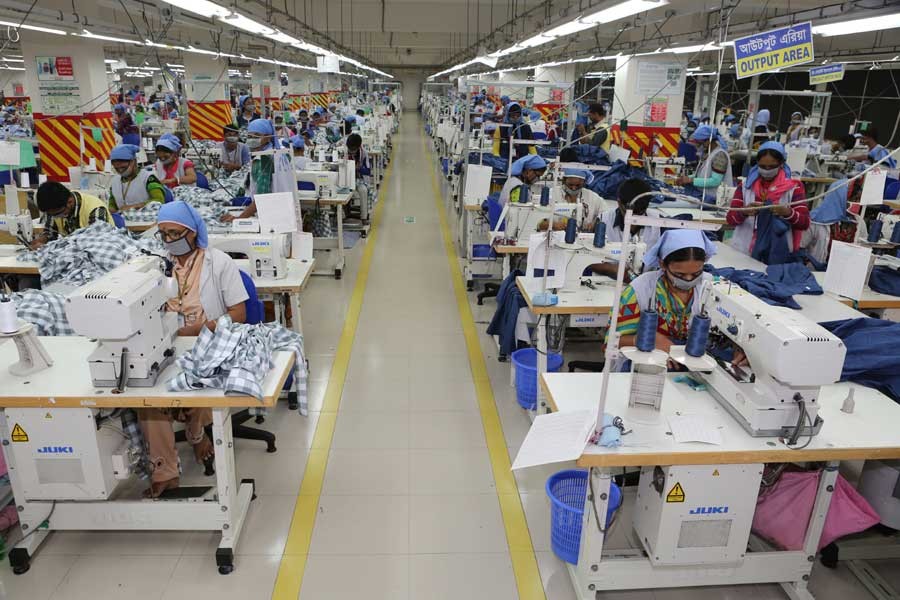An estimated US$1.2 billion would be required for remediating the safety hazards in the readymade garment factories left out of the safety inspection and remediation process so far, according to a report of the NYU Stern Centre for Business and Human Rights.
Most of them are subcontracting factories where no inspections were carried out and others are monitored by the government under a national initiative.
The report released on April 11 said some 7,000 factories, including garment, textile, dying and washing units, are operating across the country and some 3,000 of them are subcontracting units.
The remaining 4,000 factories are currently overseen under three initiatives. The foreign initiatives - the Accord and the Alliance - have improved the conditions in about 2,300 factories serving their member companies, while the Bangladeshi government under a national initiative monitors another 1,650 factories.
The report proposed forming a multi-stakeholder taskforce to fund and oversee the remediation efforts in those factories and subcontracting units where safety issue still remains a cause for concern.
The report titled 'Five Years After Rana Plaza: The Way Forward' found that many garment factories are now safer following the initiatives sponsored by western apparel brands and retailers. The moves have made a difference in about 2,300 factories employing some 2.0 million workers.
"While there has been great progress in many of the largest and best factories, workers in thousands of subcontracting factories, many of them young women, continue to work under unacceptably dangerous conditions," said Michael Posner, the director of the NYU Stern Centre.
The report said many of the factories that so far have not been remediated fully -or at all- cannot afford expensive safety improvements on their own. They lack direct relationships with western brands and retailers, it said, adding that their margins often are even slimmer than those of Accord/Alliance suppliers.
And because of their shaky financial profiles, they do not have access to local bank loans, it said, adding that without outside aid in the form of grants or low-interest loans, these factories simply will not get safer.
"This reality motivates our determination to raise a substantial fund to be distributed by a task force to those most in need. We approach this effort from the perspective of workers whose safety will be compromised until improvements are made," the Centre said.
It estimated dollar value for National Initiative remediation at $413 million, and $750 million for remediation in 3,000 sub-contracting units.
"Western consumers are the beneficiaries of the cheap clothes produced in Bangladesh. Therefore, it is incumbent on western brands and retailers, as well as western governments, to step up to the plate," Mr Posner said.
"We are calling for a model of shared responsibility, led by the government of Bangladesh that will generate the needed funds to fix these dangerous factories," he added.
Apparel sector leaders in the country, however, differed on the number of factories, saying such move would only create new complexities. They could not provide any specific statistics though.
Abdus Salam Murshedy, president of Bangladesh Exporters Association, said the NYU Stern Centre might have taken all production units into consideration, irrespective of whether they export or not, and included the small units in Keraniganj that supply garment items to only local markets.
"It is easy to propose anything but the reality is different," Mr Murshedy said, adding that small and medium-sized factories need easy loan at low interest rate to relocate, as many of them are operating in rented buildings where remediation is not possible.
Fazlul Hoque, former president of Bangladesh Knitwear Manufacturers and Exporters Association, also differed with the report that there are 7000 export-oriented garment factories in the country.
Rubana Huq, managing director of Mohammadi Group, said the cost of relocation and the cost of remediation of factories are not the same and that the costs can't be based on the amount spent on remediating the factories under the initiative of Accord or Alliance.
Land costs are high and many factories need to relocate; there are other infrastructural needs as well, she said, adding that the needs cannot be standardised and costs can't be averaged.
Regarding the proposed multi-stakeholder taskforce, the leaders came out in favour of strengthening the remediation coordination cell (RCC), saying that all the activities under the initiatives are expected to come under the purview of RCC soon.
The remediation of safety issue came to the fore in the wake of Rana Plaza tragedy that killed more than 1,100 people, mostly garment workers, and injured 2,500 on April 24, 2013.
The industrial disaster shook the global fashion industry, leading to protests at major clothing stores around the world and pledges from major brands and retailers to protect workers in their supply chains.


